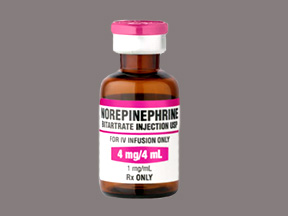Norepinephrine (Levophed)

There are a variety of vasopressors that are used to treat shock in the ICU. A vasopressor is a medication that literally makes the veins squeeze themselves tighter which raises blood pressure. Some of the common vasopressors that are used include dopamine, neosynephrine, epinephrine, and norepinephrine.
In our ICU, usually the first vasopressor of choice is norepinephrine. The majority of our patients requiring this medication are in septic shock. Norepinephrine will raise a patient's blood pressure but not their heart rate. This is advantageous in septic shock patients because their heart rates are already elevated.
The brand name of norepinephrine is Levophed. Many of the older nurses have said that they used to say, "Levophed, leave 'em dead." If patients were sick enough to require norepinephrine to manage their shock, then they were most likely going to die. Luckily, we have learned that norepinephrine is a great medication to treat hypotension if used correctly.
Pharmacy Information
The brand name of norepinephrine is Levophed. The dose that we usually give patients is 1-30 mcg/min continuously through a central line. The most frequent nursing intervention when this medication is infusing is checking the patient's blood pressure. We check the blood pressure every 15 minutes or continuously (if the patient has an arterial line). In high doses, norephinephrine can cause acute kidney injury. The medication is narrowing the veins (including the renal veins) which causes decreased perfusion to the kidneys. All medications have side effects that may not be desirable. In this case, keeping the patient's blood pressure normal is the priority.
It is a beta-1 and alpha-adrenergic agonist, meaning it activates those receptors.
- Beta 1 Receptors: Increases myocardial contraction (strength of the heart beat) and increases the heart rate.
- Alpha Receptors: Vasoconstriction, increased peripheral vascular resistance, and increased arterial blood pressure.
Norepinephrine is a very potent medication and requires a central line for administration. We may sometimes give it in low doses through a large bore peripheral IV while the provider is placing the central line. If the IV were to infiltrate, give the required subcutaneous dose of tertbutaline to stop the necrosis caused by the norepinephrine.
Pharmacokinetics
- Onset: 1-2 min
- Duration: 1-2 min (vasopressor)
- Metabolized by MAO and catechol-O-methyl transferase (COMT) in the adrenergic neuron
- Metabolites: Normetanephrine, vanillylmandelic acid (inactive)
- Excretion: Urine (84-96%)
Other relevant articles include:






